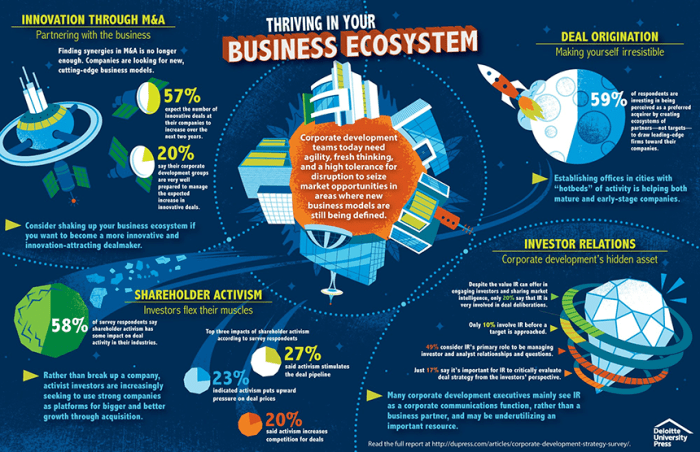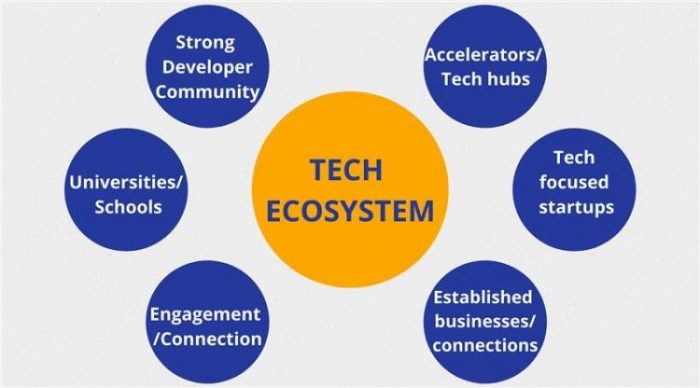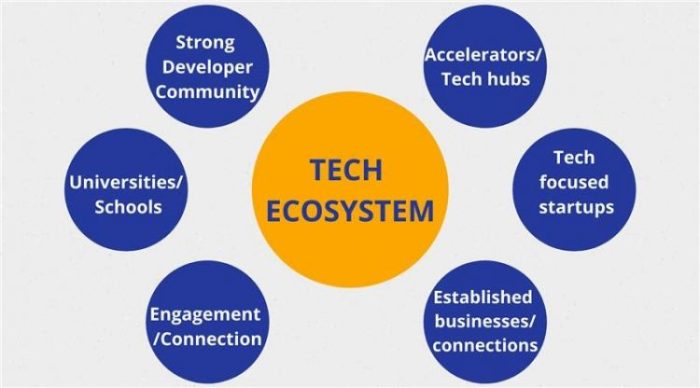Nurturing deep tech ecosystem collaboration over proprietary innovation is crucial for unlocking the transformative potential of this field. While the pursuit of individual breakthroughs is valuable, the true power of deep tech lies in its ability to create synergistic solutions that benefit society as a whole.
By fostering a culture of collaboration, we can accelerate research and development, overcome technical hurdles, and ultimately bring groundbreaking innovations to life.
Deep tech, encompassing fields like artificial intelligence, quantum computing, and biotechnology, has the power to revolutionize industries and address pressing global challenges. However, the complexity and resource-intensive nature of these technologies often make individual efforts insufficient. Collaborative approaches, where diverse expertise and resources are pooled together, become essential for achieving meaningful progress.
The Value of Collaboration in Deep Tech
Deep tech, encompassing fields like artificial intelligence, quantum computing, and biotechnology, holds immense potential to revolutionize various industries and address pressing global challenges. However, the complexity and scale of these innovations often require a collaborative approach. Collaborative innovation in deep tech is not merely a trend; it is a necessity for achieving impactful results.
Benefits of Collaborative Innovation in Deep Tech
Collaboration in deep tech offers a multitude of advantages, enabling faster development cycles, enhanced innovation, and the creation of more impactful solutions.
- Accelerated Research and Development:By pooling resources, expertise, and infrastructure, collaborative projects can significantly shorten the time required for research and development. For instance, the Human Genome Project, a collaborative effort involving hundreds of researchers worldwide, significantly accelerated our understanding of human genetics and paved the way for personalized medicine.
- Cross-Disciplinary Expertise:Deep tech often requires expertise from diverse fields, such as engineering, biology, computer science, and physics. Collaborative projects bring together experts from various disciplines, fostering cross-pollination of ideas and leading to more innovative solutions. The development of CRISPR-Cas9 gene editing technology, for example, involved collaboration between biologists, chemists, and engineers, ultimately revolutionizing gene editing capabilities.
- Reduced Costs and Risks:Developing deep tech solutions can be expensive and risky. Collaboration allows organizations to share costs, mitigate risks, and leverage collective resources, making it more feasible to pursue ambitious projects. The development of the Large Hadron Collider, a massive particle accelerator used to study the fundamental building blocks of the universe, was a collaborative effort involving multiple countries and institutions, reducing the financial burden on individual entities.
- Increased Market Reach:Collaborative projects can broaden the market reach of deep tech solutions by leveraging the networks and distribution channels of participating organizations. For instance, the collaboration between Google and NASA in the development of the Quantum Artificial Intelligence Lab (QuAIL) has facilitated the application of quantum computing technology in various fields, including space exploration and drug discovery.
Examples of Successful Deep Tech Collaborations
Numerous successful deep tech collaborations demonstrate the power of collaboration in driving innovation and creating impactful solutions.
- The Human Genome Project:This international research effort, involving hundreds of scientists from various countries, successfully mapped the entire human genome, providing a comprehensive understanding of human genetics and advancing the field of personalized medicine. The project highlights the power of collaboration in achieving ambitious scientific goals.
- The development of CRISPR-Cas9 gene editing technology:This revolutionary technology, enabling precise gene editing, resulted from the collaboration of scientists from different disciplines, including biology, chemistry, and engineering. CRISPR-Cas9 has the potential to revolutionize medicine by enabling the treatment of genetic diseases and developing novel therapies.
- The creation of the Large Hadron Collider:This massive particle accelerator, built by the European Organization for Nuclear Research (CERN), involved collaboration between scientists and engineers from various countries. The LHC has made significant contributions to our understanding of particle physics, including the discovery of the Higgs boson.
Overcoming Barriers to Collaboration
Collaboration in deep tech is crucial for accelerating innovation, but it’s not without its challenges. Deep tech companies often face hurdles that can hinder their ability to work together effectively.
Enhance your insight with the methods and methods of the mother of all typos.
Intellectual Property Concerns, Nurturing deep tech ecosystem collaboration over proprietary innovation
Intellectual property (IP) is a major concern for deep tech companies, as their innovations are often highly sensitive and valuable. The fear of losing control over their IP can prevent companies from sharing information and collaborating openly.
“IP protection is essential for deep tech companies, but it shouldn’t be a barrier to collaboration. A balance needs to be struck between protecting IP and fostering innovation through collaboration.”
Companies can overcome this challenge by:
- Implementing clear IP agreements:These agreements should define the ownership and usage rights of the IP involved in the collaboration. This provides clarity and legal protection for all parties.
- Using non-disclosure agreements (NDAs):NDAs are essential for protecting confidential information shared during collaboration. They ensure that sensitive information is not disclosed to unauthorized parties.
- Exploring joint ownership models:In some cases, companies can agree to share ownership of the IP developed through collaboration. This can incentivize greater collaboration and shared benefits.
Aligning Organizational Cultures
Deep tech companies often have distinct organizational cultures, which can create challenges when collaborating. Differences in values, communication styles, and decision-making processes can lead to misunderstandings and conflicts.Companies can address this challenge by:
- Establishing clear communication channels:Regular meetings, shared communication platforms, and clear roles and responsibilities can facilitate effective communication and understanding between teams from different organizations.
- Building trust and rapport:Trust is essential for successful collaboration. This can be built through open communication, shared experiences, and a commitment to working together towards common goals.
- Developing a shared vision:Defining a clear and compelling vision for the collaboration can help align the different organizational cultures and ensure that everyone is working towards the same objectives.
Fostering a Collaborative Ecosystem
Collaboration is the lifeblood of a thriving deep tech ecosystem. It allows for the pooling of resources, expertise, and knowledge, accelerating innovation and driving progress. To foster such an ecosystem, we must focus on building a supportive and interconnected environment that encourages collaboration.
Key Elements of a Thriving Deep Tech Ecosystem
A thriving deep tech ecosystem is characterized by several key elements that foster collaboration and innovation. These include:
- Strong Research Institutions:Universities and research labs play a crucial role in generating cutting-edge research and developing a skilled workforce. They act as incubators for deep tech startups and provide a platform for knowledge exchange.
- Vibrant Startup Community:A thriving startup ecosystem is essential for translating research into commercially viable solutions. This requires a supportive environment with access to funding, mentorship, and networking opportunities.
- Engaged Corporate Partners:Corporations can play a vital role in providing resources, expertise, and real-world applications for deep tech solutions. They can also serve as early adopters and help scale promising technologies.
- Effective Government Support:Government policies that encourage innovation, provide funding for research and development, and create a favorable regulatory environment are crucial for the success of a deep tech ecosystem.
- Strong Infrastructure:Access to high-quality infrastructure, such as broadband internet, data centers, and specialized equipment, is essential for deep tech companies to operate and grow.
Facilitating Knowledge Sharing and Resource Exchange
To foster collaboration, it’s essential to create a platform for knowledge sharing and resource exchange. This can be achieved through:
- Industry Events and Conferences:Regular conferences, workshops, and hackathons provide opportunities for researchers, entrepreneurs, and industry professionals to connect, share ideas, and collaborate on projects.
- Online Platforms and Communities:Online platforms and forums can facilitate knowledge sharing and collaboration among researchers, entrepreneurs, and investors. They can also serve as a hub for connecting individuals with shared interests.
- Shared Research Facilities:Providing access to shared research facilities, such as laboratories, equipment, and data sets, can reduce barriers to entry for startups and encourage collaboration among researchers.
- Mentorship Programs:Mentorship programs can connect experienced entrepreneurs and investors with promising startups, providing guidance and support for their growth and development.
Promoting Cross-Sector Partnerships
Deep tech innovation often requires collaboration across different sectors. To facilitate this, we can:
- Create Cross-Sectoral Platforms:Establishing platforms that bring together stakeholders from different sectors, such as healthcare, energy, and manufacturing, can foster collaboration and identify opportunities for cross-sector innovation.
- Organize Joint Research Projects:Encouraging universities, research institutions, and companies to collaborate on joint research projects can lead to breakthroughs and the development of new technologies.
- Develop Cross-Sectoral Funding Programs:Funding programs that support projects involving multiple sectors can encourage collaboration and accelerate the development of cross-sector solutions.
Establishing Industry Standards and Best Practices
Industry standards and best practices are essential for ensuring interoperability, scalability, and trust in deep tech solutions. This can be achieved through:
- Open-Source Software and Data:Encouraging the use of open-source software and data can facilitate collaboration and accelerate innovation by allowing researchers and developers to build upon existing work.
- Industry Working Groups:Establishing industry working groups can develop standards and best practices for specific technologies or applications, ensuring interoperability and compatibility.
- Certification Programs:Developing certification programs for deep tech solutions can ensure quality, reliability, and compliance with industry standards, building trust among users and stakeholders.
The Role of Government and Institutions

The role of government and research institutions is crucial in fostering a collaborative deep tech ecosystem. They act as catalysts, driving innovation and facilitating collaboration between different stakeholders.
Government Initiatives for Deep Tech Collaboration
Governments can play a significant role in promoting collaborative innovation in deep tech by creating an environment conducive to collaboration and providing support for collaborative projects. This can be achieved through various initiatives.
- Funding Programs:Governments can establish dedicated funding programs for collaborative research and development projects in deep tech. This can include grants, tax incentives, and subsidies to encourage collaboration between industry, academia, and research institutions. For example, the European Union’s Horizon Europe program provides significant funding for collaborative research and innovation projects across various fields, including deep tech.
- Regulatory Frameworks:Governments can create clear and supportive regulatory frameworks that encourage collaboration and data sharing. This includes establishing guidelines for intellectual property rights, data privacy, and cybersecurity, ensuring a fair and transparent environment for collaborative projects. For instance, the US government has implemented initiatives like the “Open Data Policy” and the “National Artificial Intelligence Research and Development Strategic Plan” to promote data sharing and collaboration in AI research.
- Public-Private Partnerships:Governments can foster collaboration by establishing public-private partnerships (PPPs) that bring together government agencies, research institutions, and industry players. These partnerships can facilitate knowledge transfer, technology commercialization, and the development of shared infrastructure. For example, the UK’s “Catapult Network” comprises specialized technology centers that collaborate with industry to accelerate innovation in various sectors, including deep tech.
Research Institutions’ Contribution
Research institutions, such as universities and national laboratories, play a critical role in driving deep tech innovation and fostering collaboration. They act as hubs for research, talent development, and knowledge dissemination.
- Research Expertise:Research institutions possess specialized expertise and cutting-edge research capabilities in various deep tech fields, such as artificial intelligence, quantum computing, and biotechnology. They can provide industry partners with access to this expertise and contribute to the development of new technologies.
- Talent Development:Universities and research institutions are responsible for training the next generation of scientists, engineers, and entrepreneurs in deep tech. They can foster collaboration by creating opportunities for students and researchers to work on collaborative projects with industry partners, thereby bridging the gap between academia and industry.
- Knowledge Dissemination:Research institutions play a vital role in disseminating research findings and fostering knowledge exchange. They can organize conferences, workshops, and seminars to connect researchers, industry professionals, and policymakers, promoting collaboration and innovation.
Importance of Funding and Investment
Funding and investment are crucial for enabling collaborative projects in deep tech. They provide the necessary resources for research, development, and commercialization.
“Collaboration in deep tech requires significant investment, as these technologies often involve long development cycles and high capital requirements.”
- Seed Funding:Early-stage collaborative projects need seed funding to support initial research, proof-of-concept development, and team building. Venture capitalists, angel investors, and government grants can provide this crucial funding.
- Series A and Beyond:As collaborative projects mature, they require additional funding for scaling up operations, developing prototypes, and conducting pilot trials. This can be secured through venture capital firms, corporate venture arms, and strategic partnerships.
- Public Funding:Government agencies and research institutions can provide grants and subsidies to support collaborative projects that align with national priorities and strategic goals. This can help to de-risk investments and encourage collaboration in areas of national importance.
Case Studies of Successful Collaboration: Nurturing Deep Tech Ecosystem Collaboration Over Proprietary Innovation

Collaboration in deep tech is not merely a theoretical concept; it is a practical reality with tangible results. Numerous companies have successfully partnered to overcome challenges, innovate faster, and create impactful solutions. These case studies highlight the power of collaboration and provide valuable insights into the factors that contribute to its success.
Deep Genomics and Novartis
Deep Genomics, a company specializing in artificial intelligence (AI) for drug discovery, partnered with Novartis, a pharmaceutical giant, to develop novel therapies for rare diseases. The collaboration leveraged Deep Genomics’ AI platform to analyze vast amounts of genetic data and identify potential drug targets.
This partnership resulted in the identification of promising candidates for treating Duchenne muscular dystrophy and other rare genetic disorders.
Key Factors Contributing to Success
- Shared Vision and Goals:Both companies shared a common goal of developing effective therapies for rare diseases, which provided a strong foundation for collaboration.
- Complementary Expertise:Deep Genomics’ AI expertise complemented Novartis’ pharmaceutical experience, creating a synergistic partnership.
- Open Communication and Trust:The partners fostered an environment of open communication and trust, allowing for effective knowledge sharing and problem-solving.
Challenges Faced and Overcoming Them
- Integration of Different Cultures:Bringing together teams from different organizations with distinct cultures required careful planning and communication to ensure smooth integration.
- Data Sharing and Intellectual Property:Balancing the need for data sharing with the protection of intellectual property required careful negotiation and agreement.
Impact of the Collaboration
The Deep Genomics-Novartis collaboration has accelerated the development of new therapies for rare diseases, bringing hope to patients who previously had limited treatment options. This success story demonstrates the potential of AI and collaboration to address unmet medical needs.
The Future of Deep Tech Collaboration
The landscape of deep tech collaboration is evolving rapidly, driven by advancements in artificial intelligence (AI), quantum computing, and other emerging technologies. This evolution will shape the future of innovation and accelerate the development of groundbreaking solutions to global challenges.
Emerging Technologies Shaping Deep Tech Collaboration
The emergence of advanced technologies is profoundly impacting the nature and scope of collaboration in deep tech. These technologies are not only accelerating innovation but also creating new opportunities for cross-disciplinary partnerships.
- AI and Machine Learning:AI-powered tools are transforming research and development by automating tasks, analyzing vast datasets, and generating insights that would be impossible for humans to uncover alone. This will lead to more efficient collaboration and faster breakthroughs. For example, AI-powered drug discovery platforms are enabling researchers from different institutions to collaborate on identifying and developing new treatments for diseases.
- Quantum Computing:Quantum computers have the potential to revolutionize fields like materials science, drug discovery, and cryptography. Collaboration will be essential to harnessing the power of quantum computing, as researchers and companies will need to pool resources and expertise to develop and implement these complex technologies.
Quantum computing is already being used in collaborative projects to design new materials with specific properties, potentially leading to breakthroughs in areas like energy storage and solar energy.
- Blockchain Technology:Blockchain technology can facilitate secure and transparent collaboration by creating a shared, immutable record of data and transactions. This can be particularly valuable in areas like supply chain management and intellectual property protection. For example, blockchain is being used to create platforms for collaborative research projects, ensuring the fair distribution of credit and ownership of intellectual property.





